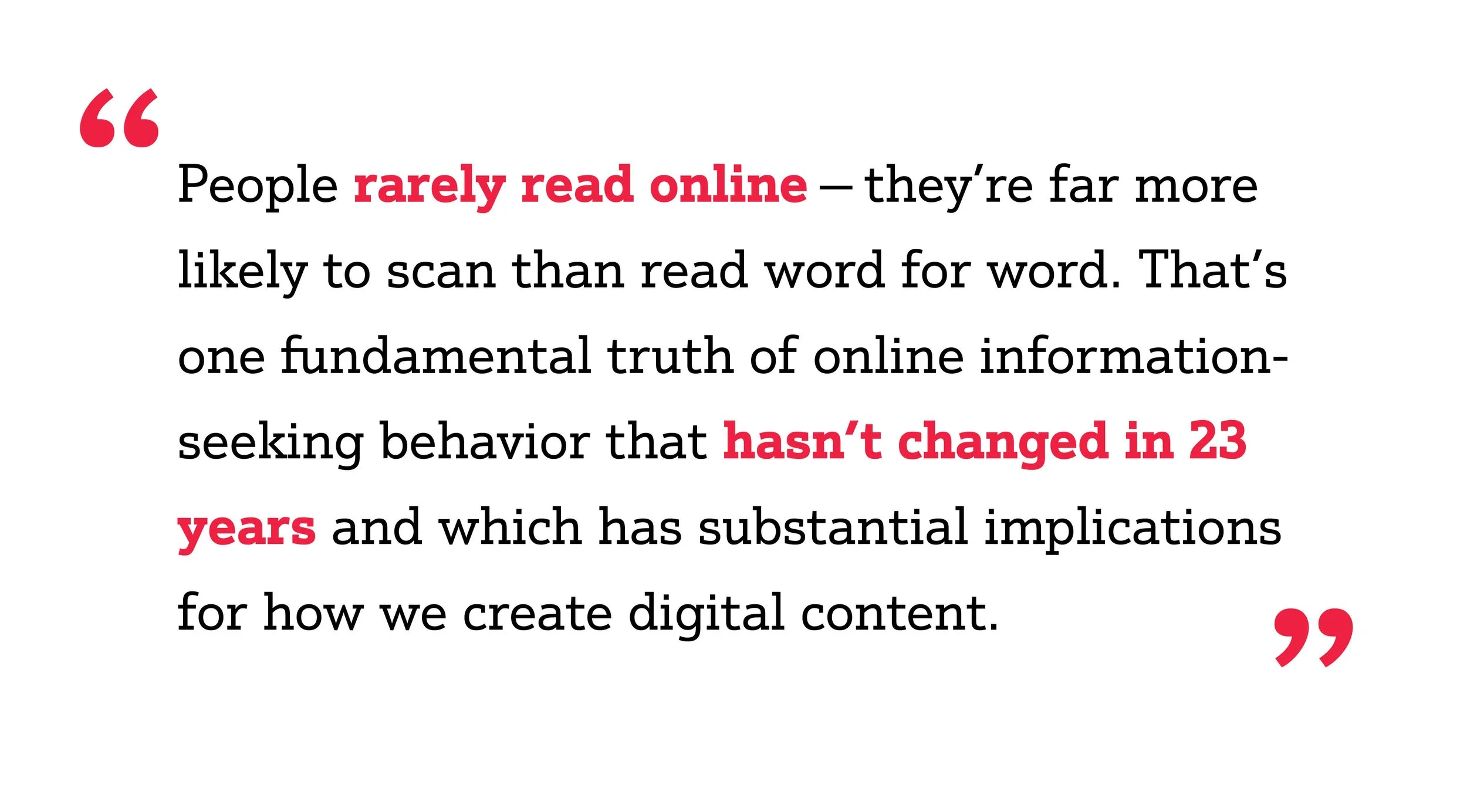Reading While Distracted: The Skimmers
Admit it. You can’t keep up with everything you need to read.
We live in an age of peak information, and it is overwhelming. It’s no wonder many of us have resorted to skimming as a means of speedy consumption.
Skimming offers an efficient approach to content consumption, allowing us to identify areas of interest swiftly and then circle back to dive deep into the most relevant content. It’s a skillful dance between speed and comprehension, a powerful tool to navigate the ever-rising tide of information inundating us daily. Skimming is an approach we all use to consume abundant digital content, and doing so impacts how we read print content as well. Even universities, those towers of learning, are teaching skimming reading behaviors to their students as a means to address reading overwhelm.
* * * * * * * * *
* * * * * * * * *
As an information designer of long-form content (print and digital), I support my publishing clients in creating text systems that captivate, engage, and facilitate engagement with readers. If our readers are skimming, we need to support them lest we lose them to publications that are more skim friendly. One approach to engage readers is to introduce way-finding mechanisms and points of entry within the text design to highlight content areas and allow readers to discover and circle back.
By crafting the visual elements of the content, we strive to empower readers to navigate quickly and efficiently. Pulling from our creative arsenal, we strategically incorporate various design techniques that serve as signposts, guiding skimmers on their journey.
A few of the many tools a designer can employ to develop points of entry:
Pull quotes, those captivating snippets plucked from the text, hold immense significance. They serve as beacons, drawing readers’ attention to key insights and compelling them to dive deeper into the narrative.
Deliberately bolding of the first words in paragraphs is a visual cue, capturing the reader’s attention and igniting curiosity. This simple yet effective technique enhances skimming efficiency, allowing individuals to swiftly assess the relevance of each paragraph before committing to a thorough read.
Boxed text creates islands of significance within the textual landscape. These carefully crafted design elements house essential information, effectively capturing skimmers’ focus.
Highlights and summaries are signposts along the skimming journey. By distilling complex ideas into bite-sized visual cues, graphic designers empower readers to swiftly grasp the core concepts without sacrificing comprehension.
Illustrations, data visualizations, and graphics breathe life into the text, making the skimming experience engaging and enlightening. These visual aids enhance comprehension, providing an instant understanding of complex ideas. By harnessing the power of imagery, designers elevate skimming beyond a mere scanning exercise, transforming it into an immersive exploration of knowledge.
Iconography becomes a language of its own, guiding skimming readers through different content areas and types. The strategic use of icons helps individuals quickly identify and navigate the text’s structure, enabling efficient information extraction.
Color, a versatile tool in the designer’s arsenal, adds depth and context to the skimming experience. By carefully selecting and applying colors, designers evoke emotions, highlight critical elements, and create visual hierarchies. Color becomes an integral part of the entry points, enabling readers to discern relevance and capture the essence of the text at a glance.
In an era of information overload, the ability to skim text is essential. Graphic design, with its thoughtful implementation of different points of entry, equips skimming readers with the tools needed to navigate the vast ocean of content. By harnessing the power of design, we unlock the potential to extract knowledge swiftly and with profound impact, enabling us to ride the wave of information rather than be overwhelmed by it.
* * * * * * * * *
Sources:
Kate Moran. (2020). "How People Read Online: New and Old Findings," Neilsen Norman Group.
Harald Weinreich, Hartmut Obendorf, Eelco Herder, and Matthias Mayer. (2008). "Not Quite the Average: An Empirical Study of Web Use," in the ACM Transactions on the Web, vol. 2, no. 1, article #5.
Fitzsimmons, G., Jayes, L. T., Weal, M. J., & Drieghe, D. (2019). "The impact of skim reading and navigation when reading hyperlinks on the web," PLoS ONE, 15(9).
Image credit:
Jenny Smith unsplash.com/@chasingafterdear
* * * * * * * * *
By combining design thinking with process experience, Studiolo Secondari evaluates your ways of working, assesses how your audience feels about your brand or your website, and oversees those big design projects that you don’t have the capacity or ability to manage. And if you’re looking to drive storytelling and showcase your message to the world, we also provide full-service book design and production — from editorial and design to composition and manufacturing.

